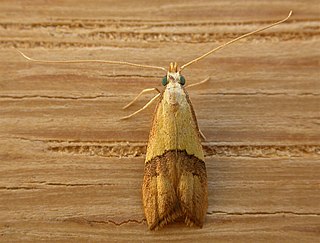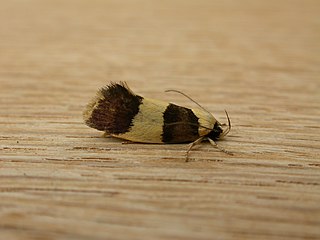
Crocanthes prasinopis is a species of moth of the family Lecithoceridae. It is found in most Australia and New Guinea.
Monerista is a genus of moth in the family Lecithoceridae. It contains the species Monerista hippastis, which is found in India (Assam).
Oxygnostis is a genus of moth in the family Lecithoceridae. It contains the species Oxygnostis diacma, which is found in Sri Lanka.

Telecrates laetiorella is a moth of the family Xyloryctidae. It is known from the Australian Capital Territory, New South Wales, Queensland, South Australia and Victoria.
Coleophora thiophaea is a moth of the family Coleophoridae. It is found in south-eastern India.
Helcystogramma verberata is a moth in the family Gelechiidae. It was described by Edward Meyrick in 1911. It is found in the Democratic Republic of the Congo, Kenya and South Africa.
Antaeotricha thapsinopa is a species of moth of the family Depressariidae. It is found in French Guiana.
Carodista melicrata is a moth in the family Lecithoceridae. It was described by Edward Meyrick in 1910. It is found in Assam, India.
Dragmatucha proaula is a moth in the family Lecithoceridae. It was described by Edward Meyrick in 1908. It is found in Botswana, Mozambique, Namibia, South Africa (Limpopo) and Zimbabwe.
Heteralcis palathodes is a moth in the family Lecithoceridae. It was described by Edward Meyrick in 1906. It is found in Sri Lanka.
Timyra autarcha is a moth in the family Lecithoceridae. It was described by Edward Meyrick in 1908. It is found in southern India.
Timyra schoenota is a moth in the family Lecithoceridae. It was described by Edward Meyrick in 1908. It is found in southern India.
Olbothrepta hydrosema is a moth in the family Lecithoceridae. It is found in southern India.
Lecithocera octonias is a moth in the family Lecithoceridae. It was described by Edward Meyrick in 1910. It is found on Borneo.
Crocanthes chordotona is a moth in the family Lecithoceridae. It was described by Edward Meyrick in 1916. It is found in Australia, where it has been recorded from Queensland.
Crocanthes perigrapta is a moth in the family Lecithoceridae. It was described by Edward Meyrick in 1904. It is found in Australia, where it has been recorded from Queensland, New South Wales and South Australia.
Crocanthes sidonia is a moth in the family Lecithoceridae. It was described by Edward Meyrick in 1910. It is found on New Guinea and Australia, where it has been recorded from Queensland.
Crocanthes temeraria is a moth in the family Lecithoceridae. It was described by Edward Meyrick in 1910. It is found on New Guinea.
Crocanthes sceletopa is a moth in the family Lecithoceridae. It was described by Edward Meyrick in 1910. It is found on the Maluku Islands in Indonesia.

Asaphodes prymnaea is a moth in the family Geometridae. It is endemic to New Zealand and can be found on the Mount Arthur tableland. It is common in limestone valleys. The female of the species is paler and has less distinctive markings than the male. Adults are on the wing in January and February.


